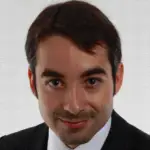
Pablo Ferrada Martínez
Pablo Ferrada graduated with a degree in Electrical Engineering from the Universidad de Santiago, Chile, in 2008. He was awarded a fellowship from the German Academic Exchange Service (DAAD) to spend an academic year at RWTH Aachen University, Germany. During his time there, he worked on his master’s thesis in Control Theory during a third semester (2006-2007). Following this period, he pursued a PhD in Applied Physics, focusing on Crystalline Silicon Solar Cells, at the University of Konstanz, Germany, completing it in 2012.
Research and teaching
Currently, he is an Assistant Professor at the Complutense University of Madrid. His research focuses on Applied Mathematics for Solar Energy Devices, including Solar Cells, Modeling Characterization approaches, and Solar Resource assessment. Additionally, he actively collaborates with the Research Center for Natural Resources, Health, and the Environment (RENSMA) at Huelva University.
During his postdoctoral period at Antofagasta University, Chile, he began implementing COMSOL Multiphysics in his research, notably studying the thermal behavior of PV modules under illumination. Through further collaboration, he introduced COMSOL to other research groups working on magnetic fields for biological systems, producing models to understand phenomena such as the influence of magnetic fields on cells.
He has delivered lectures at Antofagasta University on the device physics of solar cells and their thermal behavior, directly incorporating COMSOL Multiphysics. Additionally, he has conducted webinars organized by Addlink Software Científico on various topics related to COMSOL, including Introduction to the Software, Computational Fluid Dynamics, Heat Transfer, Electromagnetism, Acoustics, Semiconductors, and Optimization.
Numerical Simulation and COMSOL Multiphysics
He completed a Master’s degree in Numerical Simulation in Science and Engineering with COMSOL Multiphysics from Malaga University, Spain, in 2022. This degree has enabled him to bridge gaps within and between various subfields of research. One of his recent publications focused on the device physics to model a bifacial solar cell and the solar spectrum for the Atacama Desert. Additionally, he has contributed to other disciplines such as biotechnology, resulting in three papers on modeling magnetic fields and fluids for biological systems. These works highlight his abilities in interdisciplinary research and leadership.